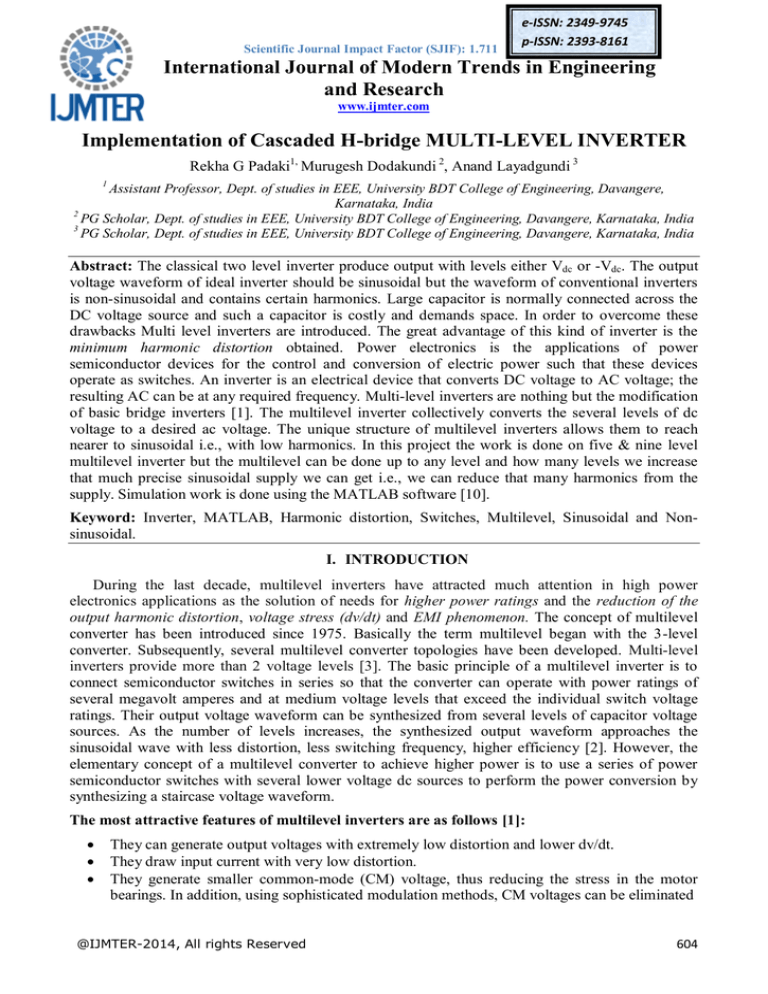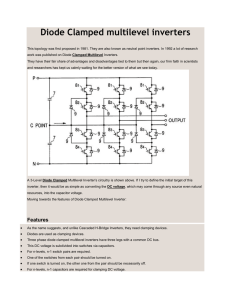
Scientific Journal Impact Factor (SJIF): 1.711
e-ISSN: 2349-9745
p-ISSN: 2393-8161
International Journal of Modern Trends in Engineering
and Research
www.ijmter.com
Implementation of Cascaded H-bridge MULTI-LEVEL INVERTER
Rekha G Padaki1, Murugesh Dodakundi 2, Anand Layadgundi 3
1
Assistant Professor, Dept. of studies in EEE, University BDT College of Engineering, Davangere,
Karnataka, India
2
PG Scholar, Dept. of studies in EEE, University BDT College of Engineering, Davangere, Karnataka, India
3
PG Scholar, Dept. of studies in EEE, University BDT College of Engineering, Davangere, Karnataka, India
Abstract: The classical two level inverter produce output with levels either Vdc or -Vdc. The output
voltage waveform of ideal inverter should be sinusoidal but the waveform of conventional inverters
is non-sinusoidal and contains certain harmonics. Large capacitor is normally connected across the
DC voltage source and such a capacitor is costly and demands space. In order to overcome these
drawbacks Multi level inverters are introduced. The great advantage of this kind of inverter is the
minimum harmonic distortion obtained. Power electronics is the applications of power
semiconductor devices for the control and conversion of electric power such that these devices
operate as switches. An inverter is an electrical device that converts DC voltage to AC voltage; the
resulting AC can be at any required frequency. Multi-level inverters are nothing but the modification
of basic bridge inverters [1]. The multilevel inverter collectively converts the several levels of dc
voltage to a desired ac voltage. The unique structure of multilevel inverters allows them to reach
nearer to sinusoidal i.e., with low harmonics. In this project the work is done on five & nine level
multilevel inverter but the multilevel can be done up to any level and how many levels we increase
that much precise sinusoidal supply we can get i.e., we can reduce that many harmonics from the
supply. Simulation work is done using the MATLAB software [10].
Keyword: Inverter, MATLAB, Harmonic distortion, Switches, Multilevel, Sinusoidal and Nonsinusoidal.
I. INTRODUCTION
During the last decade, multilevel inverters have attracted much attention in high power
electronics applications as the solution of needs for higher power ratings and the reduction of the
output harmonic distortion, voltage stress (dv/dt) and EMI phenomenon. The concept of multilevel
converter has been introduced since 1975. Basically the term multilevel began with the 3-level
converter. Subsequently, several multilevel converter topologies have been developed. Multi-level
inverters provide more than 2 voltage levels [3]. The basic principle of a multilevel inverter is to
connect semiconductor switches in series so that the converter can operate with power ratings of
several megavolt amperes and at medium voltage levels that exceed the individual switch voltage
ratings. Their output voltage waveform can be synthesized from several levels of capacitor voltage
sources. As the number of levels increases, the synthesized output waveform approaches the
sinusoidal wave with less distortion, less switching frequency, higher efficiency [2]. However, the
elementary concept of a multilevel converter to achieve higher power is to use a series of power
semiconductor switches with several lower voltage dc sources to perform the power conversion by
synthesizing a staircase voltage waveform.
The most attractive features of multilevel inverters are as follows [1]:
They can generate output voltages with extremely low distortion and lower dv/dt.
They draw input current with very low distortion.
They generate smaller common-mode (CM) voltage, thus reducing the stress in the motor
bearings. In addition, using sophisticated modulation methods, CM voltages can be eliminated
@IJMTER-2014, All rights Reserved
604
International Journal of Modern Trends in Engineering and Research (IJMTER)
Volume 02, Issue 01, [January - 2015] e-ISSN: 2349-9745, p-ISSN: 2393-8161
They can operate with a lower switching frequency.
A multilevel inverter can eliminate the need for the step-up transformer and reduce the
harmonics produced by the inverter.
With additional voltage levels, the voltage waveform has more free-switching angles, which can
be preselected for harmonics elimination.
II. MULTILEVEL INVERTER TOPOLOGIES
The three different multilevel inverter structures are as follows [1]
Diode clamped (neutral clamped)
Capacitor clamped (flying capacitor)
Cascade H-bridge inverter with separate DC source
2.1 CASCADE MULTILEVEL INVERTER
A cascade multilevel Inverter consist of series of H-bridge (Full
Bridge) Inverter units. Each bridge is fed from a separate DC sources
which may be obtained from batteries, fuel cells, or solar cells. The
general function of this multilevel inverter is to synthesize a desired
voltage from several separate dc sources (SDCSs).The ac terminal
voltages of different level inverters are connected in series [1]. Unlike
the diode-clamp or flying-capacitors inverter, the cascaded inverter
does not require voltage-clamping diodes or voltage-balancing
capacitors; hence this type has more advantages than other two types. Fig 2.1 below shows one Hbridge.
2.2 BLOCK DIAGRAM
Fig.2 shows the block diagram of implementation of microcontroller based multilevel
inverter. It mainly consists of 4 blocks Source, Cascade full bridge inverter, Control circuit and Load
[8].
DC
SUPPLY
CASCADE HBRIDGE
INVERTER
LOAD
CONTROL UNIT
(μc-89s52)
Fig.2
2.3 FIVE LEVEL INVERTER USING 2 BRIDGES
Fig. 3 shows the circuit diagram of five level inverter using 2 full H-bridge. The output
voltage level can be obtained by using only 2 full bridge inverter [5].
The different output voltage level can be obtained by closing the appropreate switches as
shown in switching sequence in Table 1. The output voltage of both the bridges is either added or
subtracted by closing respective switches to get 5 different voltage levels i.e., v1, v2, 0, -v1, -v2.
@IJMTER-2014, All rights Reserved
605
International Journal of Modern Trends in Engineering and Research (IJMTER)
Volume 02, Issue 01, [January - 2015] e-ISSN: 2349-9745, p-ISSN: 2393-8161
Fig. 3
Switching Sequence:
V\S
S1
S2
S3
S4
S5
S6
S7
S8
0
0
0
0
0
0
0
0
0
V1
1
1
0
0
0
0
0
0
V2
1
1
0
0
1
1
0
0
V1
1
1
0
0
0
0
0
0
0
0
0
0
0
0
0
0
0
-V1
0
0
1
1
0
0
0
0
-V2
0
0
1
1
0
0
1
1
-V1
0
0
1
1
0
0
0
0
0
0
0
0
0
0
0
0
0
Table 1
Table 1 shows the switching sequence for five level inverter using 2 bridges. Here level one indicates
switch is ON and level zero indicates switch is OFF.According to the above switching table we
implemented our microcontroller program.
@IJMTER-2014, All rights Reserved
606
International Journal of Modern Trends in Engineering and Research (IJMTER)
Volume 02, Issue 01, [January - 2015] e-ISSN: 2349-9745, p-ISSN: 2393-8161
Timing diagram:
Fig. 4 shows the timing diagram for 5-level inverter using 2 bridges. From this we can easily
understand how different voltage levels can be generated.
Fig. 4
Output voltage waveform:
Fig. 5 shows the output voltage wave form of 5-level using 2 bridges
Fig. 5
@IJMTER-2014, All rights Reserved
607
International Journal of Modern Trends in Engineering and Research (IJMTER)
Volume 02, Issue 01, [January - 2015] e-ISSN: 2349-9745, p-ISSN: 2393-8161
III. MATLAB SIMULATION
Single Phase 2 Bridge Circuit:
Simulation Results:
@IJMTER-2014, All rights Reserved
608
International Journal of Modern Trends in Engineering and Research (IJMTER)
Volume 02, Issue 01, [January - 2015] e-ISSN: 2349-9745, p-ISSN: 2393-8161
IV. ADVANTAGES OF MULTILEVEL INVERTERS
Multilevel inverters have the following advantages [6]:
They are suitable for medium to high power applications.
They are an ideal interface between a utility and renewable energy sources such as
photovoltaic’s or fuel cells.
Their efficiency is very high (>98%) because of the minimum switching frequency.
They can improve the power quality and dynamic stability for utility systems.
Switching Stress and EMI are low.
Because of their modular and simple structure, they can be stacked up to an almost unlimited
number of levels.
V. CONCLUSION
Microcontroller based multilevel inverter is simulated using Matlab/Simulink and the
hardware is implemented. We carried out simulation of 5-level inverters in cascaded H-bridge
topology. By using still more control strategy we can use this multi level inverter topology for more
levels and hence it will make to almost much more nearer to sine wave, which intern reduces
harmonics and which can be used for motor applications, variable speed control, in wind mills Etc.
REFERENCES
[1] Jose Rodriguez, Jih-Sheng Lai,& Fang Zheng Peng “Multilevel Inverters: A Survey of Topologies,Controls,and
Applications” IEEE Transactions on Industrial Electronics. Vol.49, No.4, August-2002.
[2] Gobinath.K, Mahendran.S and Gnanambal.I “New Cascaded H-Bridge Multilevel Inverter with Improved Efficiency”
IJAREEIE, Vol-2, Issue 4, Page No.1263-1271 April-2013.
[3] Leon M.Tolbert, Fang Z. Peng and Thomas G. Habelter “Multilevel Inverters for Electric Vehical Applications”
WPET’98, Dearborn, Michigan, Page No.79-84, October - 1998.
[4] Arvind Yadav and Jagadish Kumar “Harmonic Reduction in Cascaded Multilevel Inverter” ISSN:2277-3878, Vol-2,
Issue-2, Page No. 147-149,May-2013.
[5] Haiwen Liu, Leon M. Tolbert, Surin khomfoi, Burak Ozpineci and Zhong Du “Hybrid Cascaded Multilevel Inverter
with PWM control Method” IEEE , 978-1-4244-1668-4/08. 2008.
[6] Leon M.Tolbert and Fang Z. Peng “Multilevel converters as a Utility Interface for Renewable Energy Systems” IEEE
Vol. 02, Issue No. 01, Page No. 01-04, Year – 1998.
[7] M H Rashid, “Power Electronics: Circuits, Devices and Applications”, 3/E, 2006
[8] N.S.Sakthivel Murugan1 A.Nirmal Kumar2 T.Vijayakumar3, “Microcontroller Based Implementation of Multi-Level
Inverter Based Dynamic Voltage Restorer” Asian Power Electronics Journal, Vol. 4 No.1 April 2010.
[9] Mr. G. Pandian and Dr. S. Rama Reddy, “Implementation of Multilevel Inverter-Fed Induction Motor Drive”, Journal
of Industrial Technology • Volume 24, Number 2 • April 2008 through June 2008.
[10] G. Pandian and S. Rama Reddy, “Simulation and analysis of multilevel inverter fed induction motor drive”, Indian
Journal of Science and Technology Vol.2 No 2 (Feb. 2009) ISSN: 0974- 6846.
@IJMTER-2014, All rights Reserved
609






